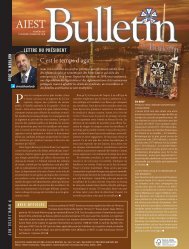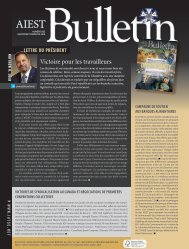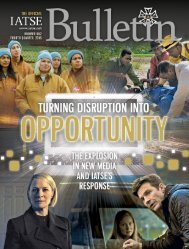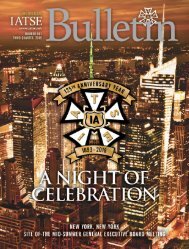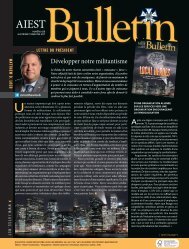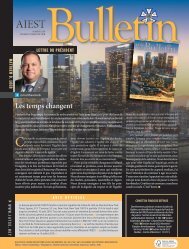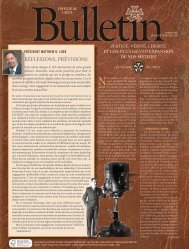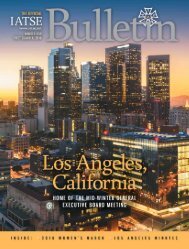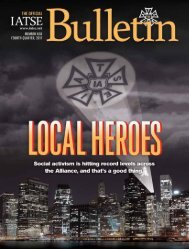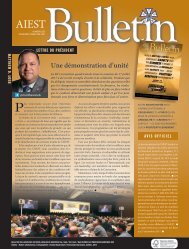IATSE-2nd2018_web
You also want an ePaper? Increase the reach of your titles
YUMPU automatically turns print PDFs into web optimized ePapers that Google loves.
1953, would be very influential throughout North America.<br />
Similar festivals sprang up in such places as Ashland, Oregon;<br />
San Diego, California; and Stratford, Connecticut.<br />
At that time, there was a reversal of the long-established<br />
tradition of shows opening on Broadway and then being taken on<br />
the road. For example, Lorelei, starring Carol Channing opened<br />
in Oklahoma City and travelled for almost a year before it went<br />
to New York. Thus, work for Alliance members was increasingly<br />
decentralized.<br />
There is one stunning example of the combination of two<br />
<strong>IATSE</strong> crafts emerging during this period: the videotaping of<br />
the Mary Martin hit, Peter Pan, for television (telecast on NBC<br />
in 1955, 1956, and 1960). This show posed enormous challenges<br />
for IA stagehands, who often held Mary Martin’s very life in<br />
their hands as she soared above, across and beyond the stage in<br />
her flying harness. Although the show had a relatively brief run<br />
on Broadway, the sale of the production to television meant it<br />
was a moneymaker after all.<br />
THE SIXTIES: DISORDERS, DISASTERS<br />
AND DECAY ON THE THEATER SCENE<br />
The riots, drugs and economic turmoil that characterized<br />
our society in the mid- and late 1960s was reflected in the theater.<br />
Ticket prices soared along with inflation. Unemployment<br />
followed, and the middle class, which had for so long set the<br />
tone for what was presented on stage, stopped attending. It<br />
was inevitable that jobs would be lost. Producers cut costs<br />
everywhere, not just in labor but in production values as well.<br />
Sets were no longer lavish and extravagant. Instead, scenery,<br />
sets, and wardrobes became sparse and meager.<br />
The situation was not helped by the fact that new talent, as<br />
soon as it succeeded on Broadway, would depart for the movies<br />
and television, where they could make much more money.<br />
Moreover, money that would have been used to mount major<br />
Broadway shows was now being diverted to the music industry<br />
and rock concerts.<br />
The sound designer took on greater importance. Local<br />
922 President and Business Agent Abe Jacobs noted that the<br />
sound designer is the “fourth member of the production and<br />
design team of a theatrical production.” Along with the scenery,<br />
costumes and lighting, sound is now recognized as a major<br />
element of the overall quality of all productions that are done<br />
today.<br />
Some of the late 1960s productions proved to be highly<br />
successful on the road, such as You’re A Good Man, Charlie<br />
Brown, and Do Your Own Thing. These shows played in<br />
legitimate theaters all across the country, setting box office<br />
records and providing much employment for <strong>IATSE</strong> members.<br />
The touring companies not only provided work for road<br />
workers, they also were a source of work for in-house crews in<br />
the cities they visited.<br />
But the Great White Way seemed unable to snap out of its<br />
lethargy. The last half of the decade produced some successes<br />
that are overshadowed by the lack of competition and innovation<br />
during this period.<br />
However, <strong>IATSE</strong> stagehands, wardrobe personnel working<br />
in tailor shops, wig and hair stylists, make-up technicians,<br />
and box office employees were still able to find steady, longterm<br />
work in such venues as the Metropolitan Opera House at<br />
Lincoln Center.<br />
This work would serve the IA well as Broadway struggled to<br />
climb out of its slump.<br />
THE STAGE IN CANADA<br />
Alliance members in Canada faced many of the struggles<br />
their American counterparts endured during this era. In<br />
1962, for example, Toronto had only two live theaters. But<br />
government funding spearheaded a revival, enabling the city<br />
51






